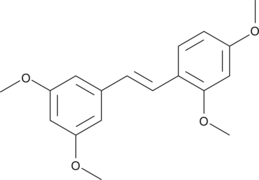Chemicals
Showing 38251–38400 of 41137 results
-
TMB is an aromatic amine that undergoes oxidation by the higher oxidation states of heme peroxidases (compounds I and II) thereby serving as a reducing co-substrate. One electron oxidation of TMB results in a radical cation that forms a charge-transfer complex with the unoxidized compound. This charge transfer complex absorbs at 652 nm (ε = 39,000).{8111} The completely oxidized form (diimine) absorbs at 450 nm (ε = 59,000) and is formed by two sequential one-electron oxidations of TMB.{8111,8109} Thus the stoichiometry of oxidation is 0.5 mole charge transfer complex (λmax = 652 nm) or 1 mole of diimine (λmax = 450 nm) formed (or TMB oxidized) per mole of hydroperoxide reduced by the peroxidase.
Brand:CaymanSKU:70450 - 1 gAvailable on backorder
TMB is an aromatic amine that undergoes oxidation by the higher oxidation states of heme peroxidases (compounds I and II) thereby serving as a reducing co-substrate. One electron oxidation of TMB results in a radical cation that forms a charge-transfer complex with the unoxidized compound. This charge transfer complex absorbs at 652 nm (ε = 39,000).{8111} The completely oxidized form (diimine) absorbs at 450 nm (ε = 59,000) and is formed by two sequential one-electron oxidations of TMB.{8111,8109} Thus the stoichiometry of oxidation is 0.5 mole charge transfer complex (λmax = 652 nm) or 1 mole of diimine (λmax = 450 nm) formed (or TMB oxidized) per mole of hydroperoxide reduced by the peroxidase.
Brand:CaymanSKU:70450 - 100 mgAvailable on backorder
TMB is an aromatic amine that undergoes oxidation by the higher oxidation states of heme peroxidases (compounds I and II) thereby serving as a reducing co-substrate. One electron oxidation of TMB results in a radical cation that forms a charge-transfer complex with the unoxidized compound. This charge transfer complex absorbs at 652 nm (ε = 39,000).{8111} The completely oxidized form (diimine) absorbs at 450 nm (ε = 59,000) and is formed by two sequential one-electron oxidations of TMB.{8111,8109} Thus the stoichiometry of oxidation is 0.5 mole charge transfer complex (λmax = 652 nm) or 1 mole of diimine (λmax = 450 nm) formed (or TMB oxidized) per mole of hydroperoxide reduced by the peroxidase.
Brand:CaymanSKU:70450 - 250 mgAvailable on backorder
TMB is an aromatic amine that undergoes oxidation by the higher oxidation states of heme peroxidases (compounds I and II) thereby serving as a reducing co-substrate. One electron oxidation of TMB results in a radical cation that forms a charge-transfer complex with the unoxidized compound. This charge transfer complex absorbs at 652 nm (ε = 39,000).{8111} The completely oxidized form (diimine) absorbs at 450 nm (ε = 59,000) and is formed by two sequential one-electron oxidations of TMB.{8111,8109} Thus the stoichiometry of oxidation is 0.5 mole charge transfer complex (λmax = 652 nm) or 1 mole of diimine (λmax = 450 nm) formed (or TMB oxidized) per mole of hydroperoxide reduced by the peroxidase.
Brand:CaymanSKU:70450 - 5 gAvailable on backorder
TMB 8 is a non-competitive antagonist of nicotinic acetylcholine receptors (nAChRs) with IC50 values of 390 and 350 nM, respectively, for human muscle-type and α3β4 subunit-containing ganglionic nAChRs expressed in TE671/RD or SH-SY5Y cells.{38552} It inhibits nicotine-induced dopamine release from rat brain synaptosomes (IC50 = 480 nM). TMB 8 also reduces calcium availability in smooth and skeletal muscle, blocking the contractile response in isolated rabbit aortic strip when used at a concentration of 50 µM and inhibiting calcium influx and efflux in isolated guinea pig ileum when used at a concentration of 65 µM.{38553} It has been used in the study of intracellular calcium dynamics, particularly in smooth muscle.{38554,38555} TMB 8 also inhibits protein kinase C (PKC) activity in a dose-dependent manner.{38556}
Brand:CaymanSKU:23928 - 10 mgAvailable on backorder
TMB 8 is a non-competitive antagonist of nicotinic acetylcholine receptors (nAChRs) with IC50 values of 390 and 350 nM, respectively, for human muscle-type and α3β4 subunit-containing ganglionic nAChRs expressed in TE671/RD or SH-SY5Y cells.{38552} It inhibits nicotine-induced dopamine release from rat brain synaptosomes (IC50 = 480 nM). TMB 8 also reduces calcium availability in smooth and skeletal muscle, blocking the contractile response in isolated rabbit aortic strip when used at a concentration of 50 µM and inhibiting calcium influx and efflux in isolated guinea pig ileum when used at a concentration of 65 µM.{38553} It has been used in the study of intracellular calcium dynamics, particularly in smooth muscle.{38554,38555} TMB 8 also inhibits protein kinase C (PKC) activity in a dose-dependent manner.{38556}
Brand:CaymanSKU:23928 - 5 mgAvailable on backorder
TMC207 is a diarylquinoline that selectively inhibits the proton pump of the mycobacterial ATP synthase.{31976} It demonstrates potent activity against both drug-sensitive and drug-resistant M. tuberculosis and other mycobacterial species with MIC50 values of ~0.03 µg/ml.{31976}
Brand:CaymanSKU:20247 -Available on backorder
TMC207 is a diarylquinoline that selectively inhibits the proton pump of the mycobacterial ATP synthase.{31976} It demonstrates potent activity against both drug-sensitive and drug-resistant M. tuberculosis and other mycobacterial species with MIC50 values of ~0.03 µg/ml.{31976}
Brand:CaymanSKU:20247 -Available on backorder
TMC207 is a diarylquinoline that selectively inhibits the proton pump of the mycobacterial ATP synthase.{31976} It demonstrates potent activity against both drug-sensitive and drug-resistant M. tuberculosis and other mycobacterial species with MIC50 values of ~0.03 µg/ml.{31976}
Brand:CaymanSKU:20247 -Available on backorder
TMC207 is a diarylquinoline that selectively inhibits the proton pump of the mycobacterial ATP synthase.{31976} It demonstrates potent activity against both drug-sensitive and drug-resistant M. tuberculosis and other mycobacterial species with MIC50 values of ~0.03 µg/ml.{31976}
Brand:CaymanSKU:20247 -Available on backorder
TMCB is a dual inhibitor of casein kinase 2 (CK2) and ERK8 (IC50 = 0.5 µM for both).{22896} It also binds to Pim-1, HIPK2, and DYRK1A (Kis = 8.65, 15.25, and 11.9 µM, respectively) and inhibits greater than 50% of the activity of five kinases, including CK2, ERK8, and DYRK2, in a panel of 78 kinases at 10 µM. TMCB induces apoptosis in Jurkat cells when used at concentrations ranging from 10 to 50 µM.
Brand:CaymanSKU:27652 - 10 mgAvailable on backorder
TMCB is a dual inhibitor of casein kinase 2 (CK2) and ERK8 (IC50 = 0.5 µM for both).{22896} It also binds to Pim-1, HIPK2, and DYRK1A (Kis = 8.65, 15.25, and 11.9 µM, respectively) and inhibits greater than 50% of the activity of five kinases, including CK2, ERK8, and DYRK2, in a panel of 78 kinases at 10 µM. TMCB induces apoptosis in Jurkat cells when used at concentrations ranging from 10 to 50 µM.
Brand:CaymanSKU:27652 - 5 mgAvailable on backorder
TMI 1 is an inhibitor of disintegrin and metalloproteinase domain-containing protein 17 (ADAM17/TACE; IC50 = 8.4 nM in a cell-free enzyme assay).{45715} It inhibits matrix metalloproteinase-1 (MMP-1), -2, -7, -9, -13, and -14, as well as ADAM-TS-4 in vitro (IC50s = 6.6, 4.7, 26, 12, 3, 26, and 100 nM, respectively). It also inhibits ADAM8, -10, -12, and -17/TACE in cell-free enzyme assays with Ki values of 21, 16, 1.8, and 0.079 nM, respectively, with slow-binding inhibition of ADAM17/TACE but not the other ADAM enzymes.{23492} TMI 1 inhibits LPS-induced TNF-α secretion in Raw and THP-1 cells (IC50s = 40 and 200 nM, respectively), as well as in isolated human monocytes and whole blood (IC50s = 190 and 300 nM, respectively).{45715} It inhibits the production of TNF-α ex vivo in synovium isolated from the inflamed joints of patients with rheumatoid arthritis with IC50 values of less than 100 nM without inhibiting TNF-α expression in vitro. TMI 1 inhibits LPS-induced TNF-α production in mice (ED50 = 5 mg/kg) and reduces disease severity in mouse models of collagen-induced arthritis. It also decreases cell viability of (ED50s = 1.3-8.1 µM), and induces caspase-3/7 activity in, a variety of cancer cell lines and induces tumor apoptosis and reduces tumor growth in an MMTV-ErbB2/neu mouse model of breast cancer when administered at a dose of 100 mg/kg.{45716}
Brand:CaymanSKU:29713 - 10 mgAvailable on backorder
TMI 1 is an inhibitor of disintegrin and metalloproteinase domain-containing protein 17 (ADAM17/TACE; IC50 = 8.4 nM in a cell-free enzyme assay).{45715} It inhibits matrix metalloproteinase-1 (MMP-1), -2, -7, -9, -13, and -14, as well as ADAM-TS-4 in vitro (IC50s = 6.6, 4.7, 26, 12, 3, 26, and 100 nM, respectively). It also inhibits ADAM8, -10, -12, and -17/TACE in cell-free enzyme assays with Ki values of 21, 16, 1.8, and 0.079 nM, respectively, with slow-binding inhibition of ADAM17/TACE but not the other ADAM enzymes.{23492} TMI 1 inhibits LPS-induced TNF-α secretion in Raw and THP-1 cells (IC50s = 40 and 200 nM, respectively), as well as in isolated human monocytes and whole blood (IC50s = 190 and 300 nM, respectively).{45715} It inhibits the production of TNF-α ex vivo in synovium isolated from the inflamed joints of patients with rheumatoid arthritis with IC50 values of less than 100 nM without inhibiting TNF-α expression in vitro. TMI 1 inhibits LPS-induced TNF-α production in mice (ED50 = 5 mg/kg) and reduces disease severity in mouse models of collagen-induced arthritis. It also decreases cell viability of (ED50s = 1.3-8.1 µM), and induces caspase-3/7 activity in, a variety of cancer cell lines and induces tumor apoptosis and reduces tumor growth in an MMTV-ErbB2/neu mouse model of breast cancer when administered at a dose of 100 mg/kg.{45716}
Brand:CaymanSKU:29713 - 5 mgAvailable on backorder
TMI-005 is an inhibitor of disintegrin and metalloproteinase domain-containing protein 17/TNF-α converting enzyme (ADAM17/TACE), matrix metalloproteinase-1 (MMP-1), and MMP-13 (IC50s = 20, 33, and 8.1 nM, respectively).{45590} It inhibits LPS-induced TNF-α release in isolated human whole blood (IC50 = 144 ng/ml).{45591} TMI-005 (25 μM) reduces basal and ionizing radiation-induced secretion of the ADAM17/TACE substrates ALCAM and amphiregulin from A549 and NCI H125 cells.{45592} It inhibits proliferation of A549 cells when used at concentrations of 25 and 50 μM and sensitizes A549 and NCI H125 cells to ionizing radiation at 25 μM. TMI-005 (25 mg/kg twice per day) reduces tumor growth in an A549 mouse xenograft model when administered in combination with ionizing radiation.
Brand:CaymanSKU:29016 - 1 mgAvailable on backorder
TMI-005 is an inhibitor of disintegrin and metalloproteinase domain-containing protein 17/TNF-α converting enzyme (ADAM17/TACE), matrix metalloproteinase-1 (MMP-1), and MMP-13 (IC50s = 20, 33, and 8.1 nM, respectively).{45590} It inhibits LPS-induced TNF-α release in isolated human whole blood (IC50 = 144 ng/ml).{45591} TMI-005 (25 μM) reduces basal and ionizing radiation-induced secretion of the ADAM17/TACE substrates ALCAM and amphiregulin from A549 and NCI H125 cells.{45592} It inhibits proliferation of A549 cells when used at concentrations of 25 and 50 μM and sensitizes A549 and NCI H125 cells to ionizing radiation at 25 μM. TMI-005 (25 mg/kg twice per day) reduces tumor growth in an A549 mouse xenograft model when administered in combination with ionizing radiation.
Brand:CaymanSKU:29016 - 10 mgAvailable on backorder
TMI-005 is an inhibitor of disintegrin and metalloproteinase domain-containing protein 17/TNF-α converting enzyme (ADAM17/TACE), matrix metalloproteinase-1 (MMP-1), and MMP-13 (IC50s = 20, 33, and 8.1 nM, respectively).{45590} It inhibits LPS-induced TNF-α release in isolated human whole blood (IC50 = 144 ng/ml).{45591} TMI-005 (25 μM) reduces basal and ionizing radiation-induced secretion of the ADAM17/TACE substrates ALCAM and amphiregulin from A549 and NCI H125 cells.{45592} It inhibits proliferation of A549 cells when used at concentrations of 25 and 50 μM and sensitizes A549 and NCI H125 cells to ionizing radiation at 25 μM. TMI-005 (25 mg/kg twice per day) reduces tumor growth in an A549 mouse xenograft model when administered in combination with ionizing radiation.
Brand:CaymanSKU:29016 - 5 mgAvailable on backorder
TMN 355 is an inhibitor of cyclophilin A (IC50 = 1.52 nM).{52619} It inhibits HIV-1 pseudoparticle infection of HEK293/T-17 cells when used at concentrations ranging from 0.1 to 1 µM.{52620}
Brand:CaymanSKU:31155 - 10 mgAvailable on backorder
TMN 355 is an inhibitor of cyclophilin A (IC50 = 1.52 nM).{52619} It inhibits HIV-1 pseudoparticle infection of HEK293/T-17 cells when used at concentrations ranging from 0.1 to 1 µM.{52620}
Brand:CaymanSKU:31155 - 5 mgAvailable on backorder
Acyl-CoA:cholesterol acyltransferase (ACAT) catalyses the esterification of excess cellular cholesterol with fatty acids and is important for intestinal cholesterol absorption, hepatic lipoprotein secretion, and cholesterol accumulation in vascular tissues. ACAT inhibitors improve plasma lipid profile and ameliorate proteinuria in nephrotic animals.{20948} TMP-153 is a quinolyl derivative that inhibits ACAT with IC50 values of 5-10 nM in various animals.{20942} At 0.5-1.5 mg/kg, TMP-153 dose-dependently reduces plasma total- and low density lipoprotein cholesterol without affecting high density lipoprotein cholesterol in hamsters.{20942} It inhibits cholesterol esterification both in human colonic adenocarcinoma L S180 cells and in human hepatoma HepG2 cells (IC50s = 150 and 330 nM, respectively).{20941} When fed as a dietary supplement (ED50 = 0.81 mg/kg/day), TMP-153 reduces hepatic cholesterogenesis in hamsters fed a stock diet.{20941}
Brand:CaymanSKU:10010516 - 10 mgAvailable on backorder
Acyl-CoA:cholesterol acyltransferase (ACAT) catalyses the esterification of excess cellular cholesterol with fatty acids and is important for intestinal cholesterol absorption, hepatic lipoprotein secretion, and cholesterol accumulation in vascular tissues. ACAT inhibitors improve plasma lipid profile and ameliorate proteinuria in nephrotic animals.{20948} TMP-153 is a quinolyl derivative that inhibits ACAT with IC50 values of 5-10 nM in various animals.{20942} At 0.5-1.5 mg/kg, TMP-153 dose-dependently reduces plasma total- and low density lipoprotein cholesterol without affecting high density lipoprotein cholesterol in hamsters.{20942} It inhibits cholesterol esterification both in human colonic adenocarcinoma L S180 cells and in human hepatoma HepG2 cells (IC50s = 150 and 330 nM, respectively).{20941} When fed as a dietary supplement (ED50 = 0.81 mg/kg/day), TMP-153 reduces hepatic cholesterogenesis in hamsters fed a stock diet.{20941}
Brand:CaymanSKU:10010516 - 25 mgAvailable on backorder
Acyl-CoA:cholesterol acyltransferase (ACAT) catalyses the esterification of excess cellular cholesterol with fatty acids and is important for intestinal cholesterol absorption, hepatic lipoprotein secretion, and cholesterol accumulation in vascular tissues. ACAT inhibitors improve plasma lipid profile and ameliorate proteinuria in nephrotic animals.{20948} TMP-153 is a quinolyl derivative that inhibits ACAT with IC50 values of 5-10 nM in various animals.{20942} At 0.5-1.5 mg/kg, TMP-153 dose-dependently reduces plasma total- and low density lipoprotein cholesterol without affecting high density lipoprotein cholesterol in hamsters.{20942} It inhibits cholesterol esterification both in human colonic adenocarcinoma L S180 cells and in human hepatoma HepG2 cells (IC50s = 150 and 330 nM, respectively).{20941} When fed as a dietary supplement (ED50 = 0.81 mg/kg/day), TMP-153 reduces hepatic cholesterogenesis in hamsters fed a stock diet.{20941}
Brand:CaymanSKU:10010516 - 5 mgAvailable on backorder
TMP-195 is an inhibitor of class IIa histone deacetylases (HDACs; Kis = 59, 60, 26, and 15 nM for HDAC4, 5, 7, and 9, respectively).{28861} It is selective for class IIa HDACs over class I and class IIb HDACs (Kis = 10-43 μM for HDAC1-3, 6, 9, and 10-11). TMP-195 blocks accumulation of chemoattractant chemokine ligand 2 (CCL2) in the supernatant of monocytes stimulated with macrophage colony-stimulating factor (CSF-1). It increases secretion of CCL1 by monocytes stimulated with CSF-1 and granulocyte/monocyte colony-stimulating factor (GM-CSF). In vivo, TMP-195 reduces tumor burden and the number of pulmonary metastases in a macrophage-dependent autochthonous mouse model of breast cancer.{42136}
Brand:CaymanSKU:23242 - 1 mgAvailable on backorder
TMP-195 is an inhibitor of class IIa histone deacetylases (HDACs; Kis = 59, 60, 26, and 15 nM for HDAC4, 5, 7, and 9, respectively).{28861} It is selective for class IIa HDACs over class I and class IIb HDACs (Kis = 10-43 μM for HDAC1-3, 6, 9, and 10-11). TMP-195 blocks accumulation of chemoattractant chemokine ligand 2 (CCL2) in the supernatant of monocytes stimulated with macrophage colony-stimulating factor (CSF-1). It increases secretion of CCL1 by monocytes stimulated with CSF-1 and granulocyte/monocyte colony-stimulating factor (GM-CSF). In vivo, TMP-195 reduces tumor burden and the number of pulmonary metastases in a macrophage-dependent autochthonous mouse model of breast cancer.{42136}
Brand:CaymanSKU:23242 - 10 mgAvailable on backorder
TMP-195 is an inhibitor of class IIa histone deacetylases (HDACs; Kis = 59, 60, 26, and 15 nM for HDAC4, 5, 7, and 9, respectively).{28861} It is selective for class IIa HDACs over class I and class IIb HDACs (Kis = 10-43 μM for HDAC1-3, 6, 9, and 10-11). TMP-195 blocks accumulation of chemoattractant chemokine ligand 2 (CCL2) in the supernatant of monocytes stimulated with macrophage colony-stimulating factor (CSF-1). It increases secretion of CCL1 by monocytes stimulated with CSF-1 and granulocyte/monocyte colony-stimulating factor (GM-CSF). In vivo, TMP-195 reduces tumor burden and the number of pulmonary metastases in a macrophage-dependent autochthonous mouse model of breast cancer.{42136}
Brand:CaymanSKU:23242 - 25 mgAvailable on backorder
TMP-195 is an inhibitor of class IIa histone deacetylases (HDACs; Kis = 59, 60, 26, and 15 nM for HDAC4, 5, 7, and 9, respectively).{28861} It is selective for class IIa HDACs over class I and class IIb HDACs (Kis = 10-43 μM for HDAC1-3, 6, 9, and 10-11). TMP-195 blocks accumulation of chemoattractant chemokine ligand 2 (CCL2) in the supernatant of monocytes stimulated with macrophage colony-stimulating factor (CSF-1). It increases secretion of CCL1 by monocytes stimulated with CSF-1 and granulocyte/monocyte colony-stimulating factor (GM-CSF). In vivo, TMP-195 reduces tumor burden and the number of pulmonary metastases in a macrophage-dependent autochthonous mouse model of breast cancer.{42136}
Brand:CaymanSKU:23242 - 5 mgAvailable on backorder
While class I HDACs are localized predominantly within the nucleus, class II HDACs shuttle into and out of the nucleus in response to intracellular signaling.{26846} Class IIa HDACs, which include HDAC4, 5, 7, and 9, commonly act as corepressors and play diverse roles in cell biology.{22864} TMP269 is a cell-permeable inhibitor of class IIa HDACs (IC50s = 126, 80, 36, and 19 nM for HDAC4, 5, 7, and 9, respectively).{28861} It contains a metal-binding group, trifluoromethyloxadiazole that confers selectivity for class IIa HDACs.{28861}
Brand:CaymanSKU:-Available on backorder
While class I HDACs are localized predominantly within the nucleus, class II HDACs shuttle into and out of the nucleus in response to intracellular signaling.{26846} Class IIa HDACs, which include HDAC4, 5, 7, and 9, commonly act as corepressors and play diverse roles in cell biology.{22864} TMP269 is a cell-permeable inhibitor of class IIa HDACs (IC50s = 126, 80, 36, and 19 nM for HDAC4, 5, 7, and 9, respectively).{28861} It contains a metal-binding group, trifluoromethyloxadiazole that confers selectivity for class IIa HDACs.{28861}
Brand:CaymanSKU:-Available on backorder
While class I HDACs are localized predominantly within the nucleus, class II HDACs shuttle into and out of the nucleus in response to intracellular signaling.{26846} Class IIa HDACs, which include HDAC4, 5, 7, and 9, commonly act as corepressors and play diverse roles in cell biology.{22864} TMP269 is a cell-permeable inhibitor of class IIa HDACs (IC50s = 126, 80, 36, and 19 nM for HDAC4, 5, 7, and 9, respectively).{28861} It contains a metal-binding group, trifluoromethyloxadiazole that confers selectivity for class IIa HDACs.{28861}
Brand:CaymanSKU:-Available on backorder
TMPD is an easily oxidizable compound that serves as a reducing co-substrate for heme peroxidases.{8584} TMPD undergoes one-electron oxidation by the heme peroxidase higher oxidation states (compounds I and II) producing a highly colored product that absorbs at 611 nm.{8581} Thus, the stoichiometry of oxidation is 2 moles of TMPD oxidized per mole of hydroperoxide reduced by the peroxidase. The extinction coefficient of the oxidized TMPD at 611 nm is 12,200.{8581} TMPD is also used for the detection of peroxidases on polyacrylamide gels.{8585}
Brand:CaymanSKU:70455 - 10 gAvailable on backorder
TMPD is an easily oxidizable compound that serves as a reducing co-substrate for heme peroxidases.{8584} TMPD undergoes one-electron oxidation by the heme peroxidase higher oxidation states (compounds I and II) producing a highly colored product that absorbs at 611 nm.{8581} Thus, the stoichiometry of oxidation is 2 moles of TMPD oxidized per mole of hydroperoxide reduced by the peroxidase. The extinction coefficient of the oxidized TMPD at 611 nm is 12,200.{8581} TMPD is also used for the detection of peroxidases on polyacrylamide gels.{8585}
Brand:CaymanSKU:70455 - 25 gAvailable on backorder
TMPD is an easily oxidizable compound that serves as a reducing co-substrate for heme peroxidases.{8584} TMPD undergoes one-electron oxidation by the heme peroxidase higher oxidation states (compounds I and II) producing a highly colored product that absorbs at 611 nm.{8581} Thus, the stoichiometry of oxidation is 2 moles of TMPD oxidized per mole of hydroperoxide reduced by the peroxidase. The extinction coefficient of the oxidized TMPD at 611 nm is 12,200.{8581} TMPD is also used for the detection of peroxidases on polyacrylamide gels.{8585}
Brand:CaymanSKU:70455 - 5 gAvailable on backorder
TMPD is an easily oxidizable compound that serves as a reducing co-substrate for heme peroxidases.{8584} TMPD undergoes one-electron oxidation by the heme peroxidase higher oxidation states (compounds I and II) producing a highly colored product that absorbs at 611 nm.{8581} Thus, the stoichiometry of oxidation is 2 moles of TMPD oxidized per mole of hydroperoxide reduced by the peroxidase. The extinction coefficient of the oxidized TMPD at 611 nm is 12,200.{8581} TMPD is also used for the detection of peroxidases on polyacrylamide gels.{8585}
Brand:CaymanSKU:70455 - 50 gAvailable on backorder
TMPyP4 is a cationic porphyrin that intercalates into and stabilizes G-quadruplexes, which are formed by DNA and RNA sequences composed of blocks of guanine residues.{29692} In this way, TMPyP4 inhibits telomerase activity (IC50 ≤ 50 µM), blocking the clonogenic growth and migration of cancer cells in culture and in vivo.{29694,29695,29696} TMPyP4 also inhibits acetylcholinesterase at doses of 0.1 to 1.0 mM.{29693}
Brand:CaymanSKU:-Available on backorder
TMPyP4 is a cationic porphyrin that intercalates into and stabilizes G-quadruplexes, which are formed by DNA and RNA sequences composed of blocks of guanine residues.{29692} In this way, TMPyP4 inhibits telomerase activity (IC50 ≤ 50 µM), blocking the clonogenic growth and migration of cancer cells in culture and in vivo.{29694,29695,29696} TMPyP4 also inhibits acetylcholinesterase at doses of 0.1 to 1.0 mM.{29693}
Brand:CaymanSKU:-Available on backorder
TMPyP4 is a cationic porphyrin that intercalates into and stabilizes G-quadruplexes, which are formed by DNA and RNA sequences composed of blocks of guanine residues.{29692} In this way, TMPyP4 inhibits telomerase activity (IC50 ≤ 50 µM), blocking the clonogenic growth and migration of cancer cells in culture and in vivo.{29694,29695,29696} TMPyP4 also inhibits acetylcholinesterase at doses of 0.1 to 1.0 mM.{29693}
Brand:CaymanSKU:-Available on backorder
TMPyP4 is a cationic porphyrin that intercalates into and stabilizes G-quadruplexes, which are formed by DNA and RNA sequences composed of blocks of guanine residues.{29692} In this way, TMPyP4 inhibits telomerase activity (IC50 ≤ 50 µM), blocking the clonogenic growth and migration of cancer cells in culture and in vivo.{29694,29695,29696} TMPyP4 also inhibits acetylcholinesterase at doses of 0.1 to 1.0 mM.{29693}
Brand:CaymanSKU:-Available on backorder
CYP1B1 is mainly an extrahepatic enzyme which oxidatively metabolizes both endogenous (steroids; eicosanoids) and exogenous xenobiotics such aspolyaromatic hydrocarbons. TMS is a potent and selective inhibitor of CYP1B1, with an IC50 of 6 nM.{10511} It is 50-fold selective for the inhibition of CYP1B1 versus CYP1A1, making it a useful tool to differentiate between various CYP450 families.{10511} In cultured human colon cancer cells, TMS induces apoptosis and inhibits cell growth with an IC50 of 0.8 µg/ml.{10510}
Brand:CaymanSKU:10038 - 1 mgAvailable on backorder
CYP1B1 is mainly an extrahepatic enzyme which oxidatively metabolizes both endogenous (steroids; eicosanoids) and exogenous xenobiotics such aspolyaromatic hydrocarbons. TMS is a potent and selective inhibitor of CYP1B1, with an IC50 of 6 nM.{10511} It is 50-fold selective for the inhibition of CYP1B1 versus CYP1A1, making it a useful tool to differentiate between various CYP450 families.{10511} In cultured human colon cancer cells, TMS induces apoptosis and inhibits cell growth with an IC50 of 0.8 µg/ml.{10510}
Brand:CaymanSKU:10038 - 10 mgAvailable on backorder
CYP1B1 is mainly an extrahepatic enzyme which oxidatively metabolizes both endogenous (steroids; eicosanoids) and exogenous xenobiotics such aspolyaromatic hydrocarbons. TMS is a potent and selective inhibitor of CYP1B1, with an IC50 of 6 nM.{10511} It is 50-fold selective for the inhibition of CYP1B1 versus CYP1A1, making it a useful tool to differentiate between various CYP450 families.{10511} In cultured human colon cancer cells, TMS induces apoptosis and inhibits cell growth with an IC50 of 0.8 µg/ml.{10510}
Brand:CaymanSKU:10038 - 5 mgAvailable on backorder
CYP1B1 is mainly an extrahepatic enzyme which oxidatively metabolizes both endogenous (steroids; eicosanoids) and exogenous xenobiotics such aspolyaromatic hydrocarbons. TMS is a potent and selective inhibitor of CYP1B1, with an IC50 of 6 nM.{10511} It is 50-fold selective for the inhibition of CYP1B1 versus CYP1A1, making it a useful tool to differentiate between various CYP450 families.{10511} In cultured human colon cancer cells, TMS induces apoptosis and inhibits cell growth with an IC50 of 0.8 µg/ml.{10510}
Brand:CaymanSKU:10038 - 50 mgAvailable on backorder
TN-16 is an inhibitor of microtubule polymerization (IC50 = 0.4-1.7 µM).{33289} It blocks taxol-induced assembly of tubulin (IC50 = 6 µM) and blocks colchicine (Item No. 9000760) binding to tubulin.{33289} Like colchicine, TN-16 inhibits alkylation of tubulin.{33292} TN-16 induces metaphase arrest in renal cell carcinoma cells.{33291} TN-16 can be used in combination with other inhibitors to enhance the efficiency of human artificial chromosome transfer to recipient cells.{33290}
Brand:CaymanSKU:21222 -Out of stock
TN-16 is an inhibitor of microtubule polymerization (IC50 = 0.4-1.7 µM).{33289} It blocks taxol-induced assembly of tubulin (IC50 = 6 µM) and blocks colchicine (Item No. 9000760) binding to tubulin.{33289} Like colchicine, TN-16 inhibits alkylation of tubulin.{33292} TN-16 induces metaphase arrest in renal cell carcinoma cells.{33291} TN-16 can be used in combination with other inhibitors to enhance the efficiency of human artificial chromosome transfer to recipient cells.{33290}
Brand:CaymanSKU:21222 -Out of stock
TN-16 is an inhibitor of microtubule polymerization (IC50 = 0.4-1.7 µM).{33289} It blocks taxol-induced assembly of tubulin (IC50 = 6 µM) and blocks colchicine (Item No. 9000760) binding to tubulin.{33289} Like colchicine, TN-16 inhibits alkylation of tubulin.{33292} TN-16 induces metaphase arrest in renal cell carcinoma cells.{33291} TN-16 can be used in combination with other inhibitors to enhance the efficiency of human artificial chromosome transfer to recipient cells.{33290}
Brand:CaymanSKU:21222 -Out of stock
TNF-α antagonist is an exocyclic peptide that mimics the critical TNF-α recognition loop on TNF receptor I complex and, thus, prevents ligand interaction with the receptor.{28742} By blocking the TNF receptor ligand contact site, this peptide interferes with both activating receptor activator of NF-κB (RANK) and TNF-α’s recruitment and activation of osteoclasts.{28741} TNF-α antagonist has been used to block bone resorption in the study of systemic bone loss in rheumatoid arthritis and inflammatory bone destruction.{28741}
Brand:CaymanSKU:-Available on backorder
TNF-α antagonist is an exocyclic peptide that mimics the critical TNF-α recognition loop on TNF receptor I complex and, thus, prevents ligand interaction with the receptor.{28742} By blocking the TNF receptor ligand contact site, this peptide interferes with both activating receptor activator of NF-κB (RANK) and TNF-α’s recruitment and activation of osteoclasts.{28741} TNF-α antagonist has been used to block bone resorption in the study of systemic bone loss in rheumatoid arthritis and inflammatory bone destruction.{28741}
Brand:CaymanSKU:-Available on backorder
TNF-α antagonist is an exocyclic peptide that mimics the critical TNF-α recognition loop on TNF receptor I complex and, thus, prevents ligand interaction with the receptor.{28742} By blocking the TNF receptor ligand contact site, this peptide interferes with both activating receptor activator of NF-κB (RANK) and TNF-α’s recruitment and activation of osteoclasts.{28741} TNF-α antagonist has been used to block bone resorption in the study of systemic bone loss in rheumatoid arthritis and inflammatory bone destruction.{28741}
Brand:CaymanSKU:-Available on backorder
TNP is a cell-permeable inhibitor of inositol-1,4,5-trisphosphate 6-kinase 1 (IP6K1; IC50 = 0.55 µM; Ki = 0.24 µM) and IP3K (IC50 = 10.2 µM; Ki = 4.3 µM) that binds to the ATP-binding sites of both enzymes. {38146,38145} TNP reduces IP7 and IP8 levels (IC50s = ~3 and 1 µM, respectively) and inhibits insulin release in MIN6 cells.{38146} It increases intracellular calcium levels in a concentration-dependent manner in HL-60 cells, potentially due to a 2- to 3-fold accumulation of IP3, and induces degranulation in mast cells.{38147}
Brand:CaymanSKU:21189 -Out of stock
TNP is a cell-permeable inhibitor of inositol-1,4,5-trisphosphate 6-kinase 1 (IP6K1; IC50 = 0.55 µM; Ki = 0.24 µM) and IP3K (IC50 = 10.2 µM; Ki = 4.3 µM) that binds to the ATP-binding sites of both enzymes. {38146,38145} TNP reduces IP7 and IP8 levels (IC50s = ~3 and 1 µM, respectively) and inhibits insulin release in MIN6 cells.{38146} It increases intracellular calcium levels in a concentration-dependent manner in HL-60 cells, potentially due to a 2- to 3-fold accumulation of IP3, and induces degranulation in mast cells.{38147}
Brand:CaymanSKU:21189 -Out of stock
TNP is a cell-permeable inhibitor of inositol-1,4,5-trisphosphate 6-kinase 1 (IP6K1; IC50 = 0.55 µM; Ki = 0.24 µM) and IP3K (IC50 = 10.2 µM; Ki = 4.3 µM) that binds to the ATP-binding sites of both enzymes. {38146,38145} TNP reduces IP7 and IP8 levels (IC50s = ~3 and 1 µM, respectively) and inhibits insulin release in MIN6 cells.{38146} It increases intracellular calcium levels in a concentration-dependent manner in HL-60 cells, potentially due to a 2- to 3-fold accumulation of IP3, and induces degranulation in mast cells.{38147}
Brand:CaymanSKU:21189 -Out of stock
TNP is a cell-permeable inhibitor of inositol-1,4,5-trisphosphate 6-kinase 1 (IP6K1; IC50 = 0.55 µM; Ki = 0.24 µM) and IP3K (IC50 = 10.2 µM; Ki = 4.3 µM) that binds to the ATP-binding sites of both enzymes. {38146,38145} TNP reduces IP7 and IP8 levels (IC50s = ~3 and 1 µM, respectively) and inhibits insulin release in MIN6 cells.{38146} It increases intracellular calcium levels in a concentration-dependent manner in HL-60 cells, potentially due to a 2- to 3-fold accumulation of IP3, and induces degranulation in mast cells.{38147}
Brand:CaymanSKU:21189 -Out of stock
TNP-470 is a synthetic analog of fumagillin (Item No. 11332) that inhibits angiogenesis. It irreversibly inactivates methionine aminopeptidase-2 (MetAP2; IC50 = 2 µM), blocking endothelial cell proliferation in vitro and angiogenesis in vivo.{26940,26939,13713} It is without effect on MetAP1.{26940} TNP-470 has therapeutic potential in cancer and microsporidiosis.{13713,26938}
Brand:CaymanSKU:-Out of stock
TNP-470 is a synthetic analog of fumagillin (Item No. 11332) that inhibits angiogenesis. It irreversibly inactivates methionine aminopeptidase-2 (MetAP2; IC50 = 2 µM), blocking endothelial cell proliferation in vitro and angiogenesis in vivo.{26940,26939,13713} It is without effect on MetAP1.{26940} TNP-470 has therapeutic potential in cancer and microsporidiosis.{13713,26938}
Brand:CaymanSKU:-Out of stock
TNP-470 is a synthetic analog of fumagillin (Item No. 11332) that inhibits angiogenesis. It irreversibly inactivates methionine aminopeptidase-2 (MetAP2; IC50 = 2 µM), blocking endothelial cell proliferation in vitro and angiogenesis in vivo.{26940,26939,13713} It is without effect on MetAP1.{26940} TNP-470 has therapeutic potential in cancer and microsporidiosis.{13713,26938}
Brand:CaymanSKU:-Out of stock
Tobramycin is an aminoglycoside antibiotic that shows potent activity against a broad spectrum of bacteria.{22658} Particularly when used in combination with quorum sensing inhibitors, it is effective against bacteria like Pseudomonas, which form biofilms during infection.{20838} Tobramycin is commonly delivered by inhalation and has applications in cystic fibrosis and bronchiectasis.{23114,23113}
Brand:CaymanSKU:-Tobramycin is an aminoglycoside antibiotic that shows potent activity against a broad spectrum of bacteria.{22658} Particularly when used in combination with quorum sensing inhibitors, it is effective against bacteria like Pseudomonas, which form biofilms during infection.{20838} Tobramycin is commonly delivered by inhalation and has applications in cystic fibrosis and bronchiectasis.{23114,23113}
Brand:CaymanSKU:-Tobramycin is an aminoglycoside antibiotic that shows potent activity against a broad spectrum of bacteria.{22658} Particularly when used in combination with quorum sensing inhibitors, it is effective against bacteria like Pseudomonas, which form biofilms during infection.{20838} Tobramycin is commonly delivered by inhalation and has applications in cystic fibrosis and bronchiectasis.{23114,23113}
Brand:CaymanSKU:-Toceranib is a small molecule, multi-targeted receptor tyrosine kinase inhibitor that is structurally related to sunitinib (Item No. 13159).{17826} It potently inhibits signaling through VEGFR, FGFR, PDGFR, and Kit.{17826} Moveover, toceranib blocks the autophosphorylation of both wild type and mutant forms of Kit in response to stem cell factor, resulting in cell death.{17826} It is active in vivo and is commonly used against solid tumors in dogs.{28879,28880}
Brand:CaymanSKU:-Available on backorder
Toceranib is a small molecule, multi-targeted receptor tyrosine kinase inhibitor that is structurally related to sunitinib (Item No. 13159).{17826} It potently inhibits signaling through VEGFR, FGFR, PDGFR, and Kit.{17826} Moveover, toceranib blocks the autophosphorylation of both wild type and mutant forms of Kit in response to stem cell factor, resulting in cell death.{17826} It is active in vivo and is commonly used against solid tumors in dogs.{28879,28880}
Brand:CaymanSKU:-Available on backorder
Toceranib is a small molecule, multi-targeted receptor tyrosine kinase inhibitor that is structurally related to sunitinib (Item No. 13159).{17826} It potently inhibits signaling through VEGFR, FGFR, PDGFR, and Kit.{17826} Moveover, toceranib blocks the autophosphorylation of both wild type and mutant forms of Kit in response to stem cell factor, resulting in cell death.{17826} It is active in vivo and is commonly used against solid tumors in dogs.{28879,28880}
Brand:CaymanSKU:-Available on backorder
Toceranib is a small molecule, multi-targeted receptor tyrosine kinase inhibitor that is structurally related to sunitinib (Item No. 13159).{17826} It potently inhibits signaling through VEGFR, FGFR, PDGFR, and Kit.{17826} Moveover, toceranib blocks the autophosphorylation of both wild type and mutant forms of Kit in response to stem cell factor, resulting in cell death.{17826} It is active in vivo and is commonly used against solid tumors in dogs.{28879,28880}
Brand:CaymanSKU:-Available on backorder
Todralazine (hydrochloride) is a β2-adrenergic receptor antagonist with peripheral vasodilator activity.{33946,33945} Administration of todralazine (5 µM) to pre-larval zebrafish led to hematopoietic cell expansion and protection from ionizing radiation.{33945} It inhibited histone acetylation in vitro and, long-term (4 months), but not short-term (1 month), treatment in mice (3 mg/day) impaired hepatocyte histone acetylation and liver regeneration.{33947}
Brand:CaymanSKU:20893 -Out of stock
Todralazine (hydrochloride) is a β2-adrenergic receptor antagonist with peripheral vasodilator activity.{33946,33945} Administration of todralazine (5 µM) to pre-larval zebrafish led to hematopoietic cell expansion and protection from ionizing radiation.{33945} It inhibited histone acetylation in vitro and, long-term (4 months), but not short-term (1 month), treatment in mice (3 mg/day) impaired hepatocyte histone acetylation and liver regeneration.{33947}
Brand:CaymanSKU:20893 -Out of stock
Todralazine (hydrochloride) is a β2-adrenergic receptor antagonist with peripheral vasodilator activity.{33946,33945} Administration of todralazine (5 µM) to pre-larval zebrafish led to hematopoietic cell expansion and protection from ionizing radiation.{33945} It inhibited histone acetylation in vitro and, long-term (4 months), but not short-term (1 month), treatment in mice (3 mg/day) impaired hepatocyte histone acetylation and liver regeneration.{33947}
Brand:CaymanSKU:20893 -Out of stock
Inhibition of fatty acid synthase (FASN) by the irreversible inhibitor cerulenin leads to cytotoxicity and apoptosis in human cancer cell lines.{11992} TOFA is an inhibitor of fatty acid synthesis blocking the synthesis of malonyl-CoA by acetyl-CoA carboxylase (ACC).{7659} Both cerulenin (at about 10 µg/ml) and TOFA (at about 1 µg/ml) are effective at blocking the incorporation of radiolabeled acetate into palmitate. However, TOFA reduces malonyl-CoA levels rather than elevating them, and TOFA is relatively non-toxic to various cancer cell lines. TOFA also attenuates the inhibition of feeding observed when FASN inhibitors such as cerulenin and C75 are administered to obese ob/ob mice.
Brand:CaymanSKU:10005263 - 10 mgAvailable on backorder
Inhibition of fatty acid synthase (FASN) by the irreversible inhibitor cerulenin leads to cytotoxicity and apoptosis in human cancer cell lines.{11992} TOFA is an inhibitor of fatty acid synthesis blocking the synthesis of malonyl-CoA by acetyl-CoA carboxylase (ACC).{7659} Both cerulenin (at about 10 µg/ml) and TOFA (at about 1 µg/ml) are effective at blocking the incorporation of radiolabeled acetate into palmitate. However, TOFA reduces malonyl-CoA levels rather than elevating them, and TOFA is relatively non-toxic to various cancer cell lines. TOFA also attenuates the inhibition of feeding observed when FASN inhibitors such as cerulenin and C75 are administered to obese ob/ob mice.
Brand:CaymanSKU:10005263 - 100 mgAvailable on backorder
Inhibition of fatty acid synthase (FASN) by the irreversible inhibitor cerulenin leads to cytotoxicity and apoptosis in human cancer cell lines.{11992} TOFA is an inhibitor of fatty acid synthesis blocking the synthesis of malonyl-CoA by acetyl-CoA carboxylase (ACC).{7659} Both cerulenin (at about 10 µg/ml) and TOFA (at about 1 µg/ml) are effective at blocking the incorporation of radiolabeled acetate into palmitate. However, TOFA reduces malonyl-CoA levels rather than elevating them, and TOFA is relatively non-toxic to various cancer cell lines. TOFA also attenuates the inhibition of feeding observed when FASN inhibitors such as cerulenin and C75 are administered to obese ob/ob mice.
Brand:CaymanSKU:10005263 - 5 mgAvailable on backorder
Inhibition of fatty acid synthase (FASN) by the irreversible inhibitor cerulenin leads to cytotoxicity and apoptosis in human cancer cell lines.{11992} TOFA is an inhibitor of fatty acid synthesis blocking the synthesis of malonyl-CoA by acetyl-CoA carboxylase (ACC).{7659} Both cerulenin (at about 10 µg/ml) and TOFA (at about 1 µg/ml) are effective at blocking the incorporation of radiolabeled acetate into palmitate. However, TOFA reduces malonyl-CoA levels rather than elevating them, and TOFA is relatively non-toxic to various cancer cell lines. TOFA also attenuates the inhibition of feeding observed when FASN inhibitors such as cerulenin and C75 are administered to obese ob/ob mice.
Brand:CaymanSKU:10005263 - 50 mgAvailable on backorder
Tofisopam (Item No. 22026) is an analytical reference standard categorized as a benzodiazepine.{39140} This product is intended for research and forensic applications.
Brand:CaymanSKU:22026 -Out of stock
Tofisopam (Item No. 22026) is an analytical reference standard categorized as a benzodiazepine.{39140} This product is intended for research and forensic applications.
Brand:CaymanSKU:22026 -Out of stock
Tofogliflozin is a potent inhibitor of sodium glucose cotransporter 2 (SGLT2) with Ki values of 2.9, 14.9, and 6.4 nM for human, rat, and mouse SGLT2, respectively.{38569} It is selective for SGLT2 (IC50 = 2.9 nM) over other SGLTs (IC50s = >1,500 nM for SGLT1 and 3-6). Tofogliflozin (3-10 mg/kg) reduces plasma glucose concentrations and increases renal glucose clearance in Zucker diabetic fatty rats in a dose-dependent manner. It also reduces hyperglycemia in non-fasted db/db mice and decreases postprandial hyperglycemia in GK rats, a non-obese model of type 2 diabetes with glucose intolerance.
Brand:CaymanSKU:23509 - 1 mgAvailable on backorder
Tofogliflozin is a potent inhibitor of sodium glucose cotransporter 2 (SGLT2) with Ki values of 2.9, 14.9, and 6.4 nM for human, rat, and mouse SGLT2, respectively.{38569} It is selective for SGLT2 (IC50 = 2.9 nM) over other SGLTs (IC50s = >1,500 nM for SGLT1 and 3-6). Tofogliflozin (3-10 mg/kg) reduces plasma glucose concentrations and increases renal glucose clearance in Zucker diabetic fatty rats in a dose-dependent manner. It also reduces hyperglycemia in non-fasted db/db mice and decreases postprandial hyperglycemia in GK rats, a non-obese model of type 2 diabetes with glucose intolerance.
Brand:CaymanSKU:23509 - 10 mgAvailable on backorder
Tofogliflozin is a potent inhibitor of sodium glucose cotransporter 2 (SGLT2) with Ki values of 2.9, 14.9, and 6.4 nM for human, rat, and mouse SGLT2, respectively.{38569} It is selective for SGLT2 (IC50 = 2.9 nM) over other SGLTs (IC50s = >1,500 nM for SGLT1 and 3-6). Tofogliflozin (3-10 mg/kg) reduces plasma glucose concentrations and increases renal glucose clearance in Zucker diabetic fatty rats in a dose-dependent manner. It also reduces hyperglycemia in non-fasted db/db mice and decreases postprandial hyperglycemia in GK rats, a non-obese model of type 2 diabetes with glucose intolerance.
Brand:CaymanSKU:23509 - 25 mgAvailable on backorder
Tofogliflozin is a potent inhibitor of sodium glucose cotransporter 2 (SGLT2) with Ki values of 2.9, 14.9, and 6.4 nM for human, rat, and mouse SGLT2, respectively.{38569} It is selective for SGLT2 (IC50 = 2.9 nM) over other SGLTs (IC50s = >1,500 nM for SGLT1 and 3-6). Tofogliflozin (3-10 mg/kg) reduces plasma glucose concentrations and increases renal glucose clearance in Zucker diabetic fatty rats in a dose-dependent manner. It also reduces hyperglycemia in non-fasted db/db mice and decreases postprandial hyperglycemia in GK rats, a non-obese model of type 2 diabetes with glucose intolerance.
Brand:CaymanSKU:23509 - 5 mgAvailable on backorder
Tolazamide is a first generation sulfonylurea that inhibits sulfonylurea receptor 1 (SUR1) linked to the inwardly rectifying potassium channel (KIR6.2; IC50 = 4.2 µM in HEK293 cells transfected with the human receptor).{36318} It has no effect on glucose uptake in L6 rat skeletal muscle cells when used at a concentration of 0.6 mg/mL but enhances glucose uptake two-fold when used in combination with insulin.{40738} In vivo, tolazamide (128 mg/kg) reduces glomerulosclerosis and albumin excretion in a rat model of insulin-dependent diabetes induced by streptozotocin (Item No. 13104).{40739} Formulations containing tolazamide have been used in the treatment of type 2 diabetes.
Brand:CaymanSKU:23545 - 10 mgAvailable on backorder
Tolazamide is a first generation sulfonylurea that inhibits sulfonylurea receptor 1 (SUR1) linked to the inwardly rectifying potassium channel (KIR6.2; IC50 = 4.2 µM in HEK293 cells transfected with the human receptor).{36318} It has no effect on glucose uptake in L6 rat skeletal muscle cells when used at a concentration of 0.6 mg/mL but enhances glucose uptake two-fold when used in combination with insulin.{40738} In vivo, tolazamide (128 mg/kg) reduces glomerulosclerosis and albumin excretion in a rat model of insulin-dependent diabetes induced by streptozotocin (Item No. 13104).{40739} Formulations containing tolazamide have been used in the treatment of type 2 diabetes.
Brand:CaymanSKU:23545 - 25 mgAvailable on backorder
Tolazamide is a first generation sulfonylurea that inhibits sulfonylurea receptor 1 (SUR1) linked to the inwardly rectifying potassium channel (KIR6.2; IC50 = 4.2 µM in HEK293 cells transfected with the human receptor).{36318} It has no effect on glucose uptake in L6 rat skeletal muscle cells when used at a concentration of 0.6 mg/mL but enhances glucose uptake two-fold when used in combination with insulin.{40738} In vivo, tolazamide (128 mg/kg) reduces glomerulosclerosis and albumin excretion in a rat model of insulin-dependent diabetes induced by streptozotocin (Item No. 13104).{40739} Formulations containing tolazamide have been used in the treatment of type 2 diabetes.
Brand:CaymanSKU:23545 - 5 mgAvailable on backorder
Tolazamide is a first generation sulfonylurea that inhibits sulfonylurea receptor 1 (SUR1) linked to the inwardly rectifying potassium channel (KIR6.2; IC50 = 4.2 µM in HEK293 cells transfected with the human receptor).{36318} It has no effect on glucose uptake in L6 rat skeletal muscle cells when used at a concentration of 0.6 mg/mL but enhances glucose uptake two-fold when used in combination with insulin.{40738} In vivo, tolazamide (128 mg/kg) reduces glomerulosclerosis and albumin excretion in a rat model of insulin-dependent diabetes induced by streptozotocin (Item No. 13104).{40739} Formulations containing tolazamide have been used in the treatment of type 2 diabetes.
Brand:CaymanSKU:23545 - 50 mgAvailable on backorder
Tolazoline is a competitive α1- and α2-adrenergic receptor antagonist (pKis ~6.5) well-known for its peripheral vasodilator effects in animal models.{30609,30610} It also is reported to produce histamine-like effects that are sensitive to histamine H2-receptor antagonism in whole animals and a variety of isolated tissues.{30608} Certain α2-adrenergic receptor antagonists, including tolazoline, are most commonly used in veterinary medicine as reversal agents for the sedative effects of α2-adrenergic receptor agonists such as xylazine (Item No. 14113).{30610}
Brand:CaymanSKU:-Available on backorder
Tolazoline is a competitive α1- and α2-adrenergic receptor antagonist (pKis ~6.5) well-known for its peripheral vasodilator effects in animal models.{30609,30610} It also is reported to produce histamine-like effects that are sensitive to histamine H2-receptor antagonism in whole animals and a variety of isolated tissues.{30608} Certain α2-adrenergic receptor antagonists, including tolazoline, are most commonly used in veterinary medicine as reversal agents for the sedative effects of α2-adrenergic receptor agonists such as xylazine (Item No. 14113).{30610}
Brand:CaymanSKU:-Available on backorder
Tolazoline is a competitive α1- and α2-adrenergic receptor antagonist (pKis ~6.5) well-known for its peripheral vasodilator effects in animal models.{30609,30610} It also is reported to produce histamine-like effects that are sensitive to histamine H2-receptor antagonism in whole animals and a variety of isolated tissues.{30608} Certain α2-adrenergic receptor antagonists, including tolazoline, are most commonly used in veterinary medicine as reversal agents for the sedative effects of α2-adrenergic receptor agonists such as xylazine (Item No. 14113).{30610}
Brand:CaymanSKU:-Available on backorder
























